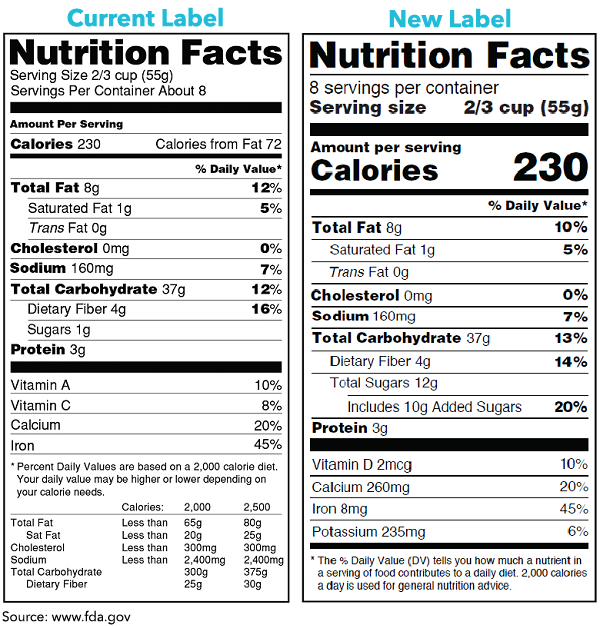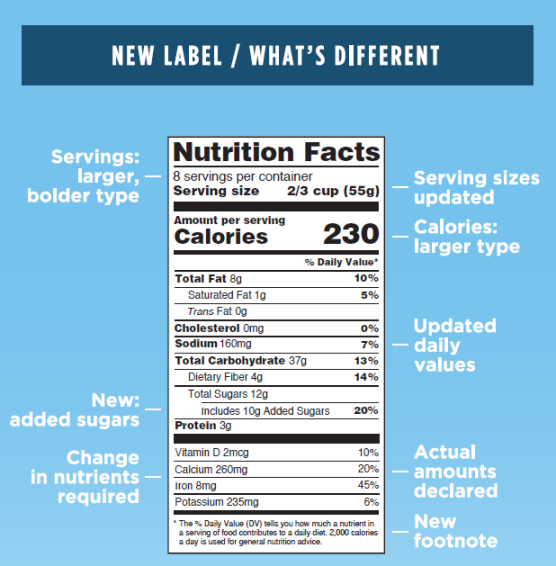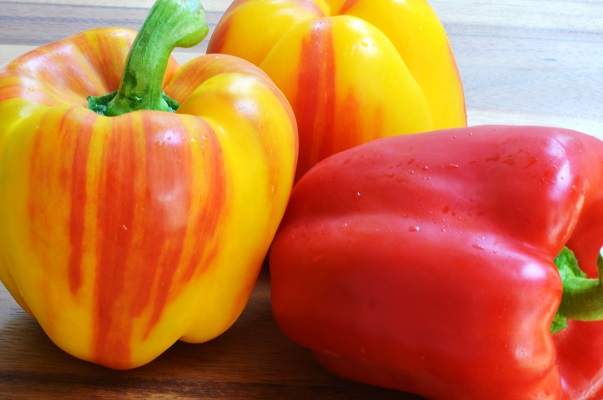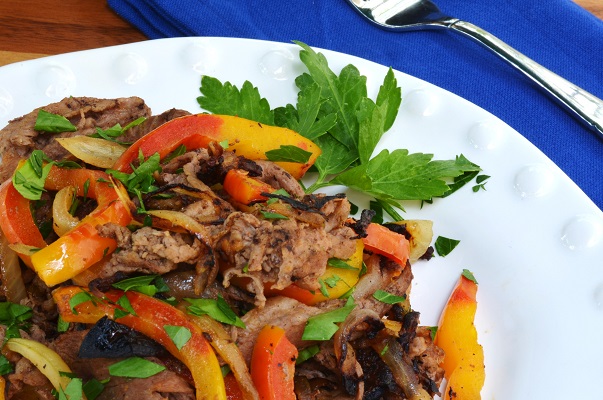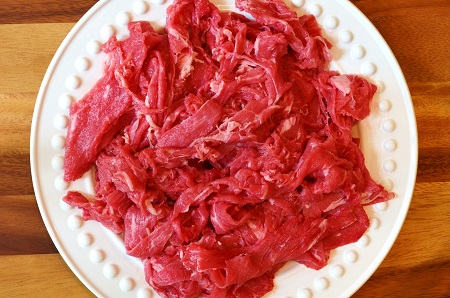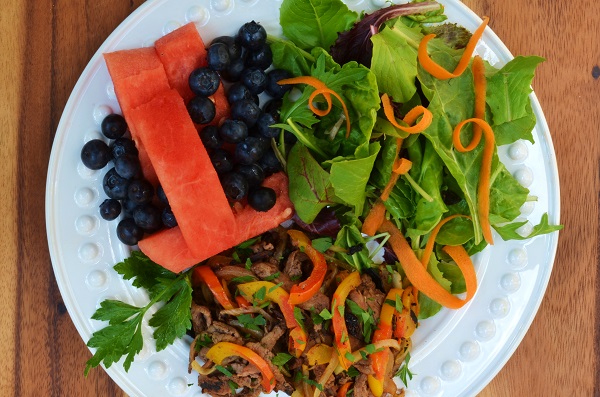If you’ve followed recent health news, you’ve read reports confirming the negative health effects of excess sugar consumption. High sugar intake has been linked to obesity, diabetes, heart disease, brain diseases and more. Numerous health organizations including the American Heart Association, American Academy of Pediatrics, Institute of Medicine (IOM) and World Health Organization (WHO) have advised consumers to decrease their daily consumption of sugar. The 2015 WHO recommendations suggest limiting Added Sugars to 5% of total calories (or about 25 grams maximum a day) while the IOM Dietary Guidelines for Americans 2015 – 2020 suggest keeping Added Sugar to less than 10% of total daily calories (or < 50 grams a day).
For those heeding the advice to reduce sugar, using the current Nutrition Facts label has been frustrating as only Total Sugars are listed. This leaves it up to the individual to decipher natural sugar from added sugar.
Since sweetened beverages and processed foods (packaged foods and fast foods) are the biggest contributors of added sugar in the American diet, the FDA proposed in 2015 that a revision of the Nutrition Facts label include a new line item declaring the amount of Added Sugars the food contains. To no one’s surprise, this proposal was met with great resistance and controversy from the food industry.
But, the FDA prevailed and on May 20, 2016 announced that the new Nutrition Facts label will include a line called “includes X g Added Sugars” under the already existing “Total Sugars” line. This will take the guess work out of reading labels so shoppers can make informed choices when buying food for themselves and their families. What a big score for consumers!
The new Nutrition Facts Label will include amount of Added Sugars! Big win for consumers! #saslife Click To TweetSo, how does the FDA define “Added Sugars”?
According to the FDA guidelines, the definition of Added Sugars includes the following:
- sugars that are either added during the processing of foods or are packaged as such
- free sugars (mono- and disaccharides)
- sugars from syrups and honey
- sugars from concentrated fruit or vegetable juices that are in excess of what would be expected from the same volume of 100 percent fruit or vegetable juice of the same type.
The definition excludes:
- fruit or vegetable juice concentrated from 100 percent fruit juice that is sold to consumers (e.g. frozen 100% fruit juice concentrate)
- some sugars found in fruit and vegetable juices, jellies, jams, preserves, and fruit spreads.
For those interested in a more technical version of the definition, the FDA invites you to refer to page 897 of the Nutrition Facts Label Final Rule here.
When can we expect to see the new Nutrition Facts labels?
We have a little wait before we see the new labels rolled out as food manufacturers have until July 26, 2018 to comply with the new food label regulations. But, we may see new Nutrition Facts labels as early as 2017. Food companies that earn less than $10 million dollars in annual sales are allowed an extra year extension on the deadline for compliance.
How can we determine Added Sugars until the new Nutrition Facts label is enforced?
Until the new Nutrition Facts label is enforced, you can use the deductive reasoning method to calculate added sugars. Click here to learn quick tips for how to calculate Added Sugars in your food.
Here are a few other changes you can expect to see on the new food label:
- Calories and serving sizes listed in larger, bolded font.
- New serving sizes showing amounts normally consumed.
- Actual amounts of nutrients (in grams, mg, mcg, etc.) instead of only %DV.
For more information on the new Nutrition Facts label, click here.
Grilled Pepper Steak
Makes 8 Servings
My inspiration for this summer recipe came from these gorgeous variegated peppers that remind me of tulips, one of my favorite flowers. Nature never ceases to amaze me at the wonders it creates! I hope you can find some of these beauties in a farmer’s market near you.
Ingredients
2-3 bell peppers of varying colors, cut in thin strips
2 Vidalia onions, cut in thin strips
2 cloves garlic, minced
1 tsp seasoned salt (see homemade recipe here) or sea salt
½ tsp black pepper
1 tsp extra virgin olive oil or vegetable cooking spray
2 lbs grass-fed beef (or pastured chicken breast),
shaved or sliced in thin strips
¼ cup flat leaf parsley, chopped
Directions
- Spread heavy duty aluminum foil across clean grill grate.
- Spray foil with vegetable cooking spray or brush with extra virgin olive oil.
- Pre-heat grill to Medium setting.
- Spread sliced peppers, onions and garlic evenly across foil. Sprinkle with ½ tsp seasoned salt.

- Using tongs, toss veggies occasionally as they cook until onions are clear and peppers are a tender crunch.

- Remove the veggies and transfer to a plate.
- Add beef or chicken to the foil. Sprinkle with the remaining ½ tsp seasoned salt and black pepper.

- Allow meat to brown on one side for about 5 minutes then toss and cook on the second side about 5 additional minutes.
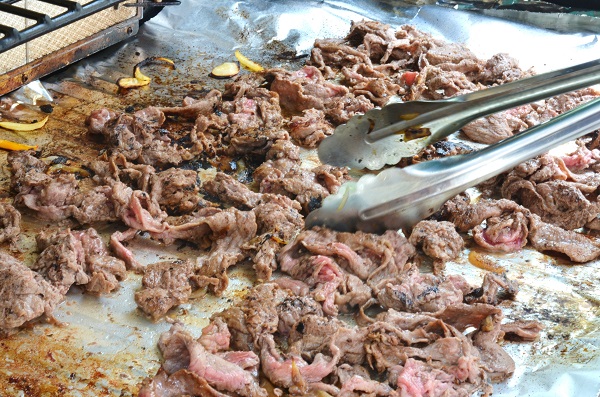
- Add veggies to the meat and toss to blend. Allow the meat and veggie mixture to cook an additional few minutes to your desired doneness.

- Remove from the grill. Garnish with chopped parsley. Serve.
Cook’s Note: If you prefer some heat, add your favorite hot sauce during cooking or when serving.
Serving Suggestions:
- For lunch, serve grilled pepper steak with a tossed salad and chilled, fresh summer fruit.
- For a quick dinner, served grilled pepper steak with brown rice, wild rice or quinoa or serve in a warm whole wheat tortilla. Compliment the plate with chilled summer fruit and a tossed salad.
Click here for a printer-friendly version of this recipe.
Click here for a printer-friendly version of this blog post.
